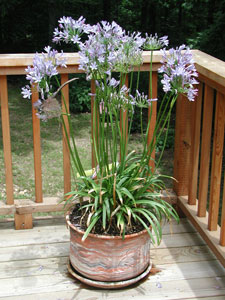Resource Library
Plant of the Week: Lily of the Nile
The University of Arkansas System Division of Agriculture does not promote, support or recommend plants featured in "Plant of the Week." Please consult your local Extension office for plants suitable for your region.
Plant of the Week
Lily of the Nile
Latin: Agapanthus praecox

With a name that translates from Greek as “lovely flower,” how could you possibly go wrong growing agapanthus? This South African perennial is a great garden plant but one most American gardeners struggle with. Sure, if you live in Florida or California it’s easy, but for the rest of us, it takes a bit of effort.
Agapanthus praecox, most commonly referred to as Lily of the Nile or sometimes African Lily, is neither from the Nile region of northern and central Africa nor is it a lily. After many unsatisfactory attempts at classification where it has flitted from the lily family to the amaryllis to the onion family, it now is classified in its own unique family, the Agapanthaceae.
Two of the six species of agapanthus, including A. praecox, are evergreen and hail from areas with year-round rainfall; the deciduous species are from areas with summer rainfall but dry winters. They grow from a congested, creeping rootstock with fleshy airplane plant-like roots. Individual plants contain up to 20 strap-shaped leaves usually about one-half inch wide and 12 to 18 inches long. The evergreen hybrids are less winter hardy than the deciduous types.
The 2- to 3-foot tall flower scape produces a softball sized terminal umbel of sky blue to indigo blue or sometimes white flowers. The umbel can contain upwards of 100 six-petaled flowers that are fused at the base to form a short tube. Each floret is attached by means of a slender peduncle. Blooms appear in late spring or early summer.
Agapanthus was one of the first plants taken back to Europe by early Dutch émigrés to South Africa, arriving sometime before its first published report in 1629 by John Parkinson (1567-1650) who produced the first book on ornamental plants, Paradisus in Sole Terresris. He thought the plant, now known as A. africanus, was a kind of crinum.
Most species in cultivation are selections of A. praecox though they’re often listed as A. africanus. In the 1950s many of the currently available selections were developed by English gardener Lewis Palmer using A. campanulata and a wide range of hybrids he grew from seeds obtained from the Kirstenbosch Botanical Garden in South Africa. His selections are called the Headbourne Hybrids and it is his work that extended the winter hardiness of the group a bit further north through zone 7b.
Some claim the cold hardy forms will survive in zone 6, but I have had no luck keeping them more than a year or two in my zone 6b garden.
Where they’re hardy outdoors, agapanthuses are easy to grow in well-drained sunny sites. They are heavy feeders so do best with the addition of a liberal dose of compost at planting to get them off to a good start. Resist the temptation of using a high nitrogen fertilizer as that will simply stimulate leaf development at the expense of flowers. Plants should be watered during the early summer as they begin to flower; later they will tolerate drier conditions.
Clumps should be divided every fourth year in early spring just as plants begin to grow.
For those of us who garden in areas too cold for agapanthus to reliably overwinter outdoors, it makes an excellent potted plant. Use at least a 12-inch pot and every couple years either shift the plant to a larger pot or divide the clump. Fertilize and water as you would any houseplant, but during the winter keep it on the dry side but not so dry the foliage dies. It’s easy to overwinter in a bright location indoors or in a cold greenhouse.
By: Gerald Klingaman, retired
Extension Horticulturist - Ornamentals
Extension News - September 14, 2007
The University of Arkansas System Division of Agriculture does not maintain lists of retail outlets where these plants can be purchased. Please check your local nursery or other retail outlets to ask about the availability of these plants for your growing area.